Text and Photographs by Norbert Schiller
The Baron Empain Palace served as the home of Edouard Louis Joseph Empain considered the founder of Cairo’s suburb of Heliopolis. A Belgian transportation magnate who earned his nobility title after building the Paris metro, Empain expanded his empire east arriving in Egypt in the early 20th century. After developing the Cairo tramway, Empain set his eyes on the wasteland northeast of Cairo where he envisioned a brand-new extension to the city that would be the emblem of luxury and leisure. He wanted his home to be an eye-catcher at the center of this new development with stunning views over the Giza Pyramids and the desert, so he hired a talented French architect to come up with a majestic design. Even after the baron’s death in 1929 the palace continued to thrive until the 1952 revolution that overthrew the monarchy in Egypt. The abandoned structure and grounds began to deteriorate becoming dilapidated until a recent effort by the government to revive them.

Baron Empain Palace during Heliopolis’s glory days and today after its restoration. Norbert Schiller Collection
Edouard Louis Joseph Empain was born in 1852 to a modest family in Beloeil, Belgium. He was the first of seven children whose father worked as a schoolteacher. After finishing his basic education, Empain went on to become an apprentice draughtman at the Metallurgic Society in Brussels. With financial help from the society, he was able to purchase a small marble quarry, and, in a short time acquired a few more quarries proving early on that he was a shrewd businessman. Shifting gears, Empain saw opportunities in public transportation and began building a network of tramway lines around Belgium, northern France, and Holland. In order to grow, Empain needed capital, so he founded his own bank, Banque Empain, later renamed Banque Industrielle Belge. Once he secured his finances, Empain expanded his tramway empire into China, the Congo, Italy, Spain, France, Turkey, and Egypt. To avoid dependence on electricity suppliers, Empain formed his own electricity companies to power his tramway projects. In 1897, he was awarded the main concession to build the Paris metro which in turn earned him the title of baron.

An electric tram on Emad El Din street in the center of Cairo in the 1930s. The Cairo Electric Railways and Heliopolis Oasis Company share dividends in 1906 when the company was first formed. Norbert Schiller Collection
In 1904, after losing the concession to build the railway line from Al Matariyah outside of Cairo, to Port Said, Empain went back to trams and established the first tramway line in Cairo. It was then that the baron fell in love with Egypt. After forming in 1906 the Belgian transport magnet partnered with Boghos Nubar Pasha, the son of the former Egyptian Prime Minster Nubar Pasha to create “a city of luxury and leisure.” Since desert land outside the capital was cheap, Empain began purchasing parcels of land. Heliopolis, or City of the Sun, was the name given to the new suburb in reference to the ancient Egyptian city located nearby. It was developed to include all the facilities one could ask for including broad boulevards, running water, proper drainage, electricity, hotels, electric tramway, parks, and for entertainment a golf course, a sporting club and a horse racetrack. However, what set this new suburb apart from anything else was the architecture.

Heliopolis, “a city of luxury and leisure,” blending Moorish, Persian, Arab and neoclassical European designs. This architectural style became known as the “Heliopolis style.” Norbert Schiller Collection
Empain was determined to create a suburb with its own distinguished style of architecture. Hence, a blend of Moorish, Persian, Arab and neoclassical European designs was adopted to create what became known as the “Heliopolis style” which combines the aesthetics and functional aspects of all these inspirations. The baron’s front man, who was responsible for making his dream a reality, was the architect and fellow countryman Ernest Jaspar. In order to attract people to move to Heliopolis, hospitals, shops, restaurants, and houses of worship were added. The latter included a mosque and a series of churches catering to Greek Orthodox, Greek Catholics, Catholics, Armenians, Copts, and various protestant sects. A synagogue was later built to serve the Jewish community. Besides private villas and apartments, there were rental units. Baron Empain thought of everything that would be needed to create a brand-new urban center in the desert. Today, Heliopolis still has the best examples of the “Heliopolis style” architecture in the world.
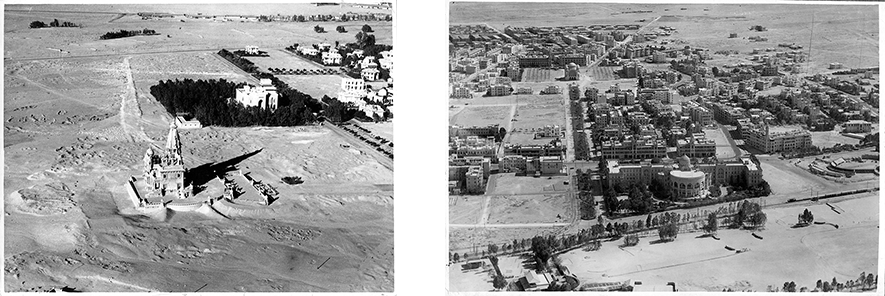
An early 20th century aerial view of the Baron Empain Palace surrounded by sand, alongside a view of Heliopolis and the Heliopolis Palace Hotel in the foreground. Norbert Schiller Collection
With the new suburb sprouting out of the sand. Baron Empain was not finished; he still had to build his own home. Empain chose a parcel of land on the most eastern end of Heliopolis from where he would have an open view of the desert to the east, Heliopolis to the west and the Giza Pyramids far in the distance to the southwest. He hired the French architect, Alexandre Marcel who had earned his fame from his designs at the 1900 Paris exposition. Marcel, known for his fusion of Indian and east Asian architecture, now had the task of creating a palace befitting a baron. Work on the Empain palace or Hindu temple, as is sometimes referred to, commenced in 1907 and was completed in 1911. Besides the palace, Marcel also designed the giant dome inside the Heliopolis Palace Hotel, (later renamed al Ittihadiya and turned into a presidential palace under President Mubarak) and the Heliopolis Basilica, which became the burial place of Baron Empain.

The Heliopolis Palace Hotel which became the al Ittihadiya palace under Hosni Mubarak in the 1980s. Mubarak receiving Princess Diana at the al Ittihadiya palace in 1992. Norbert Schiller Collection
Some accounts claim that Marcel modeled the baron’s palace after the Angkor Wat temple in Cambodia. Others assert that it was inspired by the Kandariya Mahadev temple in Khajuraho, India. After reading several explanations, my conclusion is that Marcel’s design had been influenced by that of various temples in Asia and, as a result, turned out to be truly unique. He went on to add an array of buddhas, elephants, snakes and other gargoyle type creatures to the outside to give the façade a distinctive flair. The 12,500 square meter two-story palace, with its spiral staircase leading up through a tower to a roof terrace, was built using reinforced concrete which was a novelty in Egypt at the time. Marcel’s colleague, George Louis-Claude, designed the interior adding all the décor.
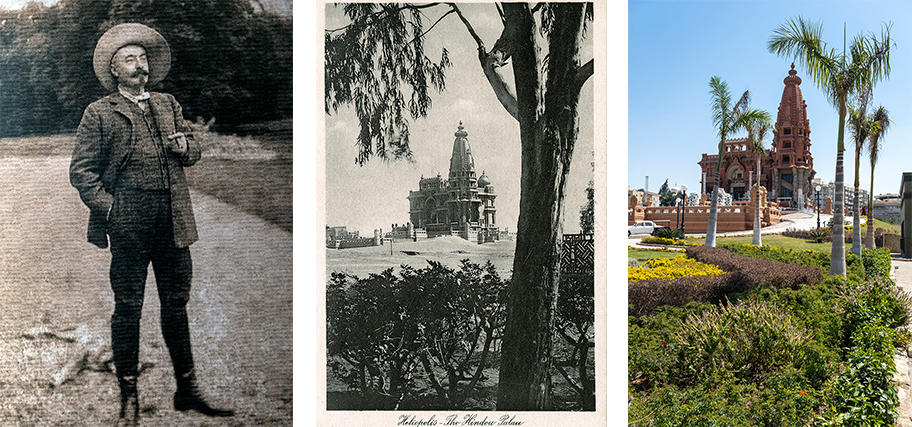
Baron Edouard Louis Joseph Empain. A view of the Baron palace from the southwest corner in the 1930s and today. Phot. (L) Courtesy Baron Palace Museum. (C) Norbert Schiller Collection
When the palace was finished, it became the talk of the town. After the Baron and his family moved in, an invitation to the Empain home became the most sought-after social event in all of Cairo. With the outbreak of WWI, Baron Empain went back to Belgium and was given the rank of Major-General in the Belgium army. It is not clear where he lived during the decade after the war ended, but what is confimed is that Empain passed away in Belgium in 1929 and was repatriated to Egypt to be buried in the Heliopolis Basilica. Following his death, Empain’s sons Jean and Louis took over the business and their families continued living in the palace until the 1952 coup that brought Gamal Abdel Nasser and his military junta to power. In 1957, the palace was auctioned off and thereafter began its slow decline until it was nearly forgotten as one of the relics from Heliopolis’s more glamorous past.
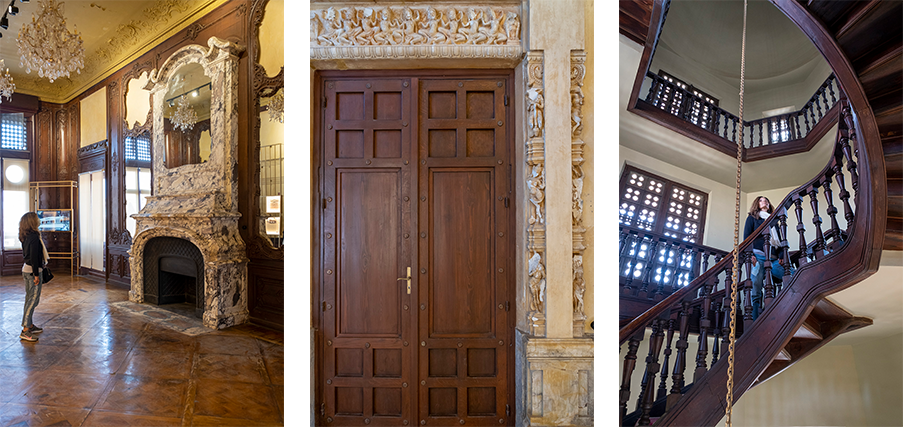
The palace’s interior decor, circular staircase, and carved marble was designed by George Louis-Claude
There is so much contradictory information about Baron Empain’s life and that of his family that it is hard to come up with an accurate account. For example, there are rumors that he had a daughter who was locked up in the palace apparently due to a medical condition that was considered a stigma at the time. If she did exist, there is no trace of when or how she eventually died. The death of his wife remains a mystery as well. According to some rumors, she fell from the top of the spiral staircase while others claim that she committed suicide.

The Baron palace rooftop with its pillars and gargoyles. A view of modern Heliopolis from the palace’s rooftop.
After the palace was abandoned and fell into disrepair, it became a place of intrigue entwined in wild tales of evildoing taking place within the palace grounds. In the late 1990s, the young Egyptian elite revolted against society’s conservative values which they were hoping to change. Within this context, some groups held gatherings at night in the desert or in old abandon buildings where they got high and danced to heavy metal rock music. One of these locations was the Baron Empain Palace which due to its “haunted house” appearance was a favorite hangout venue to the rebelling youth. When the local press got wind of these counter-culture activities, they went on a witch hunt accusing the teens of blasphemy, devil worshipping, and sexual orgies. The situation escalated when the police began conducting raids in posh neighborhoods including Heliopolis, confiscating material such as video tapes, CDs, pop posters, and anything they thought was damaging to the Egyptian youth. It got to a point were wearing a black dress or t-shirt, black lipstick, having a tattoo, or wearing silver jewelry was suspect behavior. Around a hundred youths were taken in for interrogation and their names and “confessions” made public. The story became so significant that even the western press took an interest publishing articles about this social phenomenon. Fortunately, when the media hype subsided, the prosecutor in the case backed down and all serious charges were dropped. The authorities had succeeded in sending a message that such rebellious behavior would not be tolerated in a country with traditional religious values.

Egypt’s rebellious youth accused of devil worshiping and orgies in the desert and in the compound of the Baron Empain palace made headlines in the middle of Ramadan, 1997. Besides extensive local coverage the international press had a field day with the story. Above is an article by Douglas Jehl of the New York Times and Richard Engel of the Middle East Times before he became CBS Chief Foreign Correspondent.
In 1993 the Baron’s palace was declared a national monument and in 2005. The Ministry of Housing then acquired the property compensating the owner with land and entrusting the palace to the Ministry of Culture. In 2017 restoration work began and was completed in 2020. Today the Empain Palace Museum is open to the public and serves as a reminder of Egypt’s glory days.
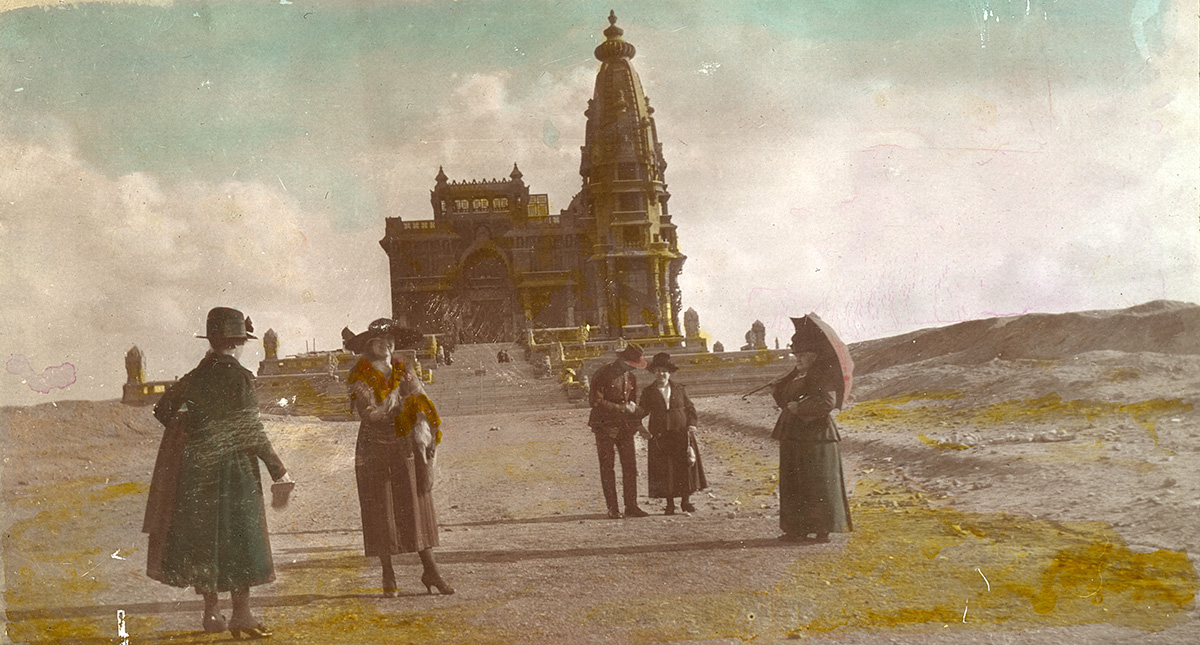
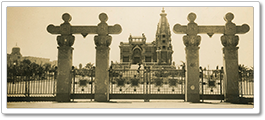
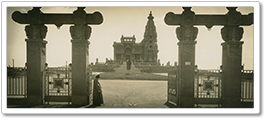
Hi
I’m interested in where the fifth picture down comes from, the one featuring the Dewars Whisky advert.
I have a copy of this exact picture in my fathers collection of photographs.
I’ve always assumed my father took it, he was a keen photographer and was sationed with the RAF in Heliopolis in 1945-6.
It is amongst a set of his photographs featuring various parts of the city and includes some portraits of him and his comrades.